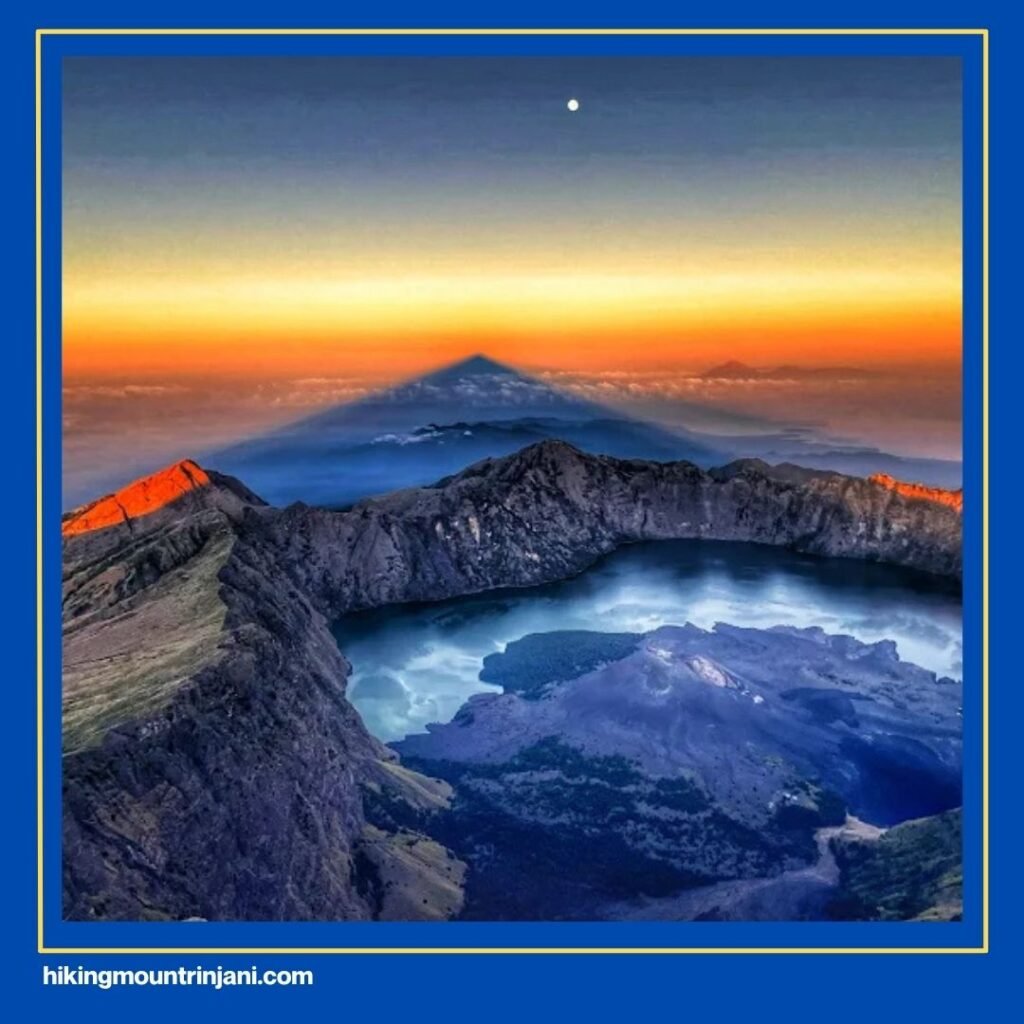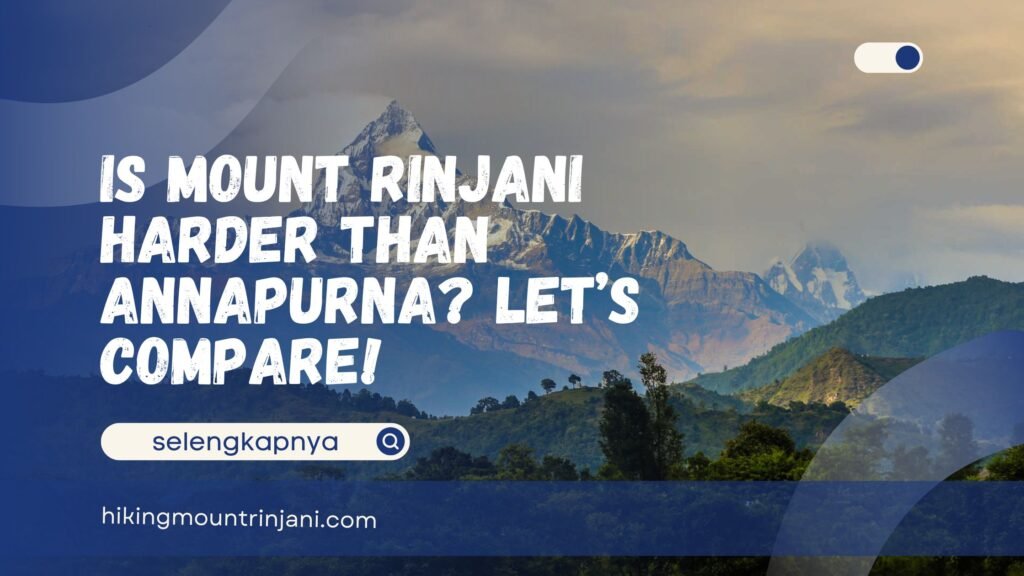Is Rinjani Harder Than Annapurna – For many adventure seekers, the question isn’t just where to climb next—it’s how hard that journey will be. Two of Asia’s most iconic mountains, Mount Rinjani in Indonesia and Annapurna I in Nepal, often come up in conversations among trekkers and climbers alike.
At first glance, both peaks promise breathtaking scenery, a test of endurance, and a sense of spiritual accomplishment. But if you’ve ever wondered, “Is Rinjani harder than Annapurna?” This article will help you understand what sets them apart. From their terrain and altitude to the overall trekking experience.
Before we compare them side by side, let’s get to know each mountain more deeply.
Getting to Know the Full Trek of Mount Rinjani

Standing tall at 3,726 meters (12,224 feet), Mount Rinjani is the second-highest volcano in Indonesia, located on the island of Lombok. Despite being lower than many Himalayan peaks, Rinjani presents a physically demanding trek that surprises many first-time climbers.
What makes Rinjani unique is the combination of steep volcanic terrain, loose gravel paths, and drastic elevation gain over relatively short distances. The trek typically starts from Sembalun or Senaru, two gateway villages that frame the mountain’s famous crater rim.
The classic Rinjani Trek takes about 2–3 days to complete, depending on your chosen route and physical condition. Most hikers aim to reach the summit viewpoint, which offers a panoramic sunrise view over the Segara Anak crater lake and, on a clear day, even Mount Agung in Bali. But that final ascent to the summit is notoriously tough — steep, slippery, and often windy. Many climbers say it feels like “two steps forward, one step back.”
Despite the challenge, Rinjani offers something magical beyond its difficulty: diversity in landscape. The route takes you through tropical rainforests, savanna hills, volcanic sand ridges, and finally to a surreal crater lake at 2,000 meters above sea level. The lake, Segara Anak, holds sacred meaning for the local Sasak and Balinese people, often used as a place of offerings and spiritual reflection.
While Rinjani’s trek demands stamina, it doesn’t require advanced mountaineering skills. There’s no need for technical climbing gear, just solid physical fitness, mental resilience, and good coordination with your trekking guide and porter team. That’s why many travelers choose Rinjani as their first serious mountain challenge before attempting higher Himalayan expeditions.
.
Read Also: Mt Rinjani Tour Options: Trekking and Non-Trekking for Foreign
Rinjani Harder Than Annapurna? About Annapurna I from a Climber’s Perspective

When you hear the name Annapurna, one of the first things that come to mind is grandeur and danger. Located in north-central Nepal, Annapurna I stands at 8,091 meters (26,545 feet), making it the 10th highest mountain in the world. And one of the most feared among professional mountaineers.
Yet, not all adventures around Annapurna require extreme risk. The Annapurna region is famous for its trekking routes, especially the Annapurna Circuit and the Annapurna Base Camp (ABC) trek. These routes are among the most scenic and culturally rich trekking experiences in the Himalayas.
Trekking to Annapurna Base Camp is considered relatively accessible compared to other high-altitude treks. As you walk through lush forests, terraced fields, and charming Gurung villages, your anticipation to witness Annapurna I up close keeps your spirit high. Reaching the base camp feels like entering a natural amphitheater surrounded by giants. Not only Annapurna I but also Machapuchare (Fishtail) and Hiunchuli.
However, there’s another side to Annapurna. The mountain itself has earned a notorious reputation for its unpredictability. Historically, Annapurna I has one of the highest fatality rates among 8,000-meter peaks, particularly from the southern face. Harsh weather, avalanches, and unstable snow conditions have turned many expeditions into tragic stories.
For trekkers, though, the Annapurna Circuit offers a safer and more achievable challenge. The route spans 10 to 21 days, depending on your pace, covering diverse terrains. From subtropical forests to alpine meadows and even high-altitude deserts.
The highlight for many is crossing Thorong La Pass at 5,416 meters (17,769 feet), one of the highest trekking points in the world. This crossing is both breathtaking and physically demanding, often testing one’s endurance and mental strength.
While Annapurna’s summit climb belongs to elite mountaineers, its trekking routes remain among the most beautiful and rewarding journeys for adventurers of all levels.
Is Rinjani Harder Than Annapurna? Let’s Compare!

So, when comparing Rinjani vs Annapurna, what truly makes one harder than the other? Let’s break it down into a few key aspects:
1. Altitude and Acclimatization
Annapurna clearly wins in elevation. Even the base camp sits at around 4,130 meters, while Rinjani’s summit is 3,726 meters. However, altitude sickness can hit harder in the Himalayas due to prolonged exposure above 3,000 meters.
In contrast, Rinjani’s trek happens within a shorter time frame, giving your body less time to adjust. So, while it’s lower, the rapid ascent on Rinjani can feel just as punishing.
2. Terrain and Technical Difficulty
Rinjani’s trails are steep, sandy, and slippery, especially near the summit. Every step requires balance and focus. Annapurna’s trails, on the other hand, are longer but more stable, often paved with stone steps or dirt paths.
However, the Thorong La Pass crossing in the Annapurna Circuit can be exhausting due to thin air and freezing temperatures.
In short:
- Rinjani = short, intense, steep volcanic terrain.
- Annapurna = long, gradual, high-altitude endurance trek.
3. Duration and Endurance
Rinjani treks usually last 2–3 days, while the Annapurna Circuit or ABC trek can take 10–21 days. Annapurna requires more time, planning, and stamina over several days of hiking.
However, because Rinjani’s trek is concentrated into steep climbs within a shorter period, it can feel more intense in the moment.
4. Safety and Accessibility
Rinjani is relatively safe when guided by local porters and managed by the national park authority. Weather conditions can be unpredictable but rarely life-threatening.
Annapurna, however, has a history of fatal avalanches and severe weather, especially in the higher routes or during off-season treks.
So, is Rinjani harder than Annapurna?
- If we’re talking about trekking intensity, Rinjani feels harder due to its steep and relentless climb.
- But if we’re talking about altitude challenge and endurance, Annapurna wins hands down.
In essence, Rinjani tests your legs and lungs, while Annapurna tests your stamina and patience.
For most climbers, Mount Rinjani is the perfect training ground before tackling the Himalayas. It gives you a taste of altitude, exhaustion, and triumph, all within a few days.
.
Read Also: Know the Sembalun Rinjani Trek – Read This Before You Decide!
Planning to Hike Mount Rinjani? It’s Easier with Us!

If reading this makes you want to experience Rinjani firsthand, don’t worry, you don’t have to do it alone.
Hiking Mount Rinjani invites you to join our journey with experienced guides and porters who know every trail, rest point, and scenic spot along the way. Let’s discuss the route you prefer, the moments you want to capture, and how long you wish to stay at each point. We love helping climbers create a custom trekking experience that matches their pace and goals.
You won’t have to worry about logistics. From airport pickup and meals to camping gear and accommodation, we handle everything. All you need to bring is your personal gear and adventurous spirit — our team will take care of the rest.
Ready to take the challenge? Contact us today:
- Website: hikingmountrinjani.com
- WhatsApp: +6287878841703
And let’s make your Mount Rinjani trekking experience smooth, memorable, and truly yours.
Whether you choose to trek the lush trails of Annapurna or climb the volcanic ridges of Rinjani, both offer an unforgettable test of strength, humility, and connection with nature. But if you’re new to mountain trekking and want a challenge that’s tough yet achievable, Rinjani might be the perfect start — a beautiful mix of difficulty, reward, and discovery.
.

